Do petro-dollar shifts in Canadian economy explain Harper government?
Mar 26th, 2006 | By Randall White | Category: Key Current Issues Would there be so much talk these days about “the economic capital of Canada rapidly moving west” (Thomas Courchene in the latest Inside Queen’s Park newsletter), if the 2006 election had delivered another Ontario-dominated Liberal minority government instead of a new Alberta-dominated Conservative minority government in Ottawa?
Would there be so much talk these days about “the economic capital of Canada rapidly moving west” (Thomas Courchene in the latest Inside Queen’s Park newsletter), if the 2006 election had delivered another Ontario-dominated Liberal minority government instead of a new Alberta-dominated Conservative minority government in Ottawa?
Or, do Canadians have a new minority Conservative government because oil-rich Calgary and not Toronto (or Vancouver for that matter?) has suddenly become the “new centre of the universe” in Canada (see the Saturday, March 25 issue of the Toronto Globe and Mail)?
Whatever the right answers, some aging jaded observers may also complain about deja vu all over again. The international energy/oil shocks of the late 1970s and early 1980s spread similar rumours about the westward shift of the Canadian economic centre of gravity. And then as the 1980s wore on the price of oil started falling again, and the evil empire Ontario recovered its status as the most rapidly growing region of the country.
Will this pattern finally be repeated too, at some point down the road? Or does the new “the West is in” phenomenon signal some much more enduring longer-term change in the underlying economic base of Canadian federal politics? (Something like what has happened in the elephant next door, as growth has shifted out of the US north and east and into the south and west over the past several decades?)
Some current population growth numbers …
 Population growth is not quite the same thing as economic growth. But in a country like Canada it does tend to reflect longer-term economic development trends.
Population growth is not quite the same thing as economic growth. But in a country like Canada it does tend to reflect longer-term economic development trends.
According to recent Statistics Canada data, the population of Canada at large increased by 4.0% between 2001 and the middle of 2005. But, as usual, not all provinces grew at more or less the same rate. Three provinces grew faster than the cross-country average (while the other seven grew more slowly) – Alberta at 6.5%, Ontario at 5.4%, and BC at 4.3%.
To some degree, these numbers underplay the extent to which Alberta alone has dramatically raced ahead of the pack in the most recent and shortest-term past. Over the third quarter of 2004, e.g., Ontario’s population increased by 0.4% – and then it increased by 0.4% again over the third quarter of 2005. BC’s population increased by 0.3% over the same period in 2004, and then by a somewhat stronger 0.4% in 2005. But Alberta’s population, which had also grown by 0.3% in 2004 suddenly leapt ahead by 0.8% in 2005. (And now just-released Stats Can data for the fourth quarter of 2005 shows Alberta surging ahead much more vigorously again.)
It is these very last kind of most recent population numbers which most closely tie in with the current spring 2006 perception that: “Clearly, Calgary is having its moment. Its economy is on fire. Help Wanted signs are everywhere. It’s the Prime Minister’s home riding. Some are calling it the new capital of Canada. The population has swelled to nearly a million, and more than 2,000 newcomers arrive every month.”
CHANGING PROVINCIAL POPULATIONS, 2001 MID 2005
|
2001 |
2005 |
% Change |
|
|
Alberta |
3,056.7 |
3,256.8 |
6.5 |
|
Ontario |
11,897.6 |
12,541.4 |
5.4 |
|
BC |
4,078.4 |
4,254.5 |
4.3 |
|
CANADA |
31,021.3 |
32,270.5 |
4.0 |
|
Quebec |
7,397.0 |
7,598.1 |
2.7 |
|
Manitoba |
1,151.3 |
1,177.6 |
2.3 |
|
PEI |
136.7 |
138.1 |
1.0 |
|
NS |
932.4 |
937.9 |
0.6 |
|
NB |
749.9 |
752.0 |
0.3 |
|
Saskatchewan |
1,000.1 |
994.1 |
0.6 |
|
Nfld & Lab |
522.0 |
516.0 |
1.1 |
SOURCE: Statistics Canada.
 At the same time, the total population of Alberta was only 26% of Ontario’s total population in 2005 – about 3.25 million people as opposed to 12.5 million. Even if Alberta’s current surge of growth continues for a very long time, it will still be quite a while before it surpasses Ontario on this kind of absolute number (as the total population of Texas, e.g., has recently surpassed the total population of the old empire state in New York).
At the same time, the total population of Alberta was only 26% of Ontario’s total population in 2005 – about 3.25 million people as opposed to 12.5 million. Even if Alberta’s current surge of growth continues for a very long time, it will still be quite a while before it surpasses Ontario on this kind of absolute number (as the total population of Texas, e.g., has recently surpassed the total population of the old empire state in New York).
The picture here improves somewhat if you combine the BC and Alberta populations, to get a composite number for the rising new Canadian West at large. BC and Alberta together had about 7.5 million people in 2005 – or about 23% of the Canada-wide total. This gives the two most westerly provinces combined almost the same current demographic weight as Quebec. And it is up appreciably from the 19% of the Canada-wide population that BC and Alberta together accounted for a generation ago, in 1976.
At the same time again, even this picture remains a great distance from the current US model next door, that always figures so prominently in the comparative Canadian mind. California (which is now home to some 36 million people – or more than all of Canada combined) supplanted New York as the most populous state of the Union as long ago as 1970. (And then Texas supplanted New York as the second most populous state in 2000.)
It is these kinds of absolute numbers, it would seem, that Ontario Liberal premier Dalton McGunity was concerned to remind all Canadians about in his recent remarks on Senate reform. Whatever else may or may not be true, Ontario is going to remain Canada’s most populous province for some considerable time yet. (And if and when it is supplanted at last in this respect, it will still likely enough be BC and not Alberta that turns the trick?)
The traditional diversity of the Ontario regional economy
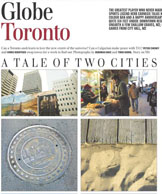 Another somewhat hasty impression also seems to be abroad in the land these days, in connection with the underlying sources of Ontario’s traditional economic strength. Many observers searching for convenient thumbnail sketches of current trends have been contrasting the present strengths of the western resource-based regional economy with the present strains in Ontario’s manufacturing economy.
Another somewhat hasty impression also seems to be abroad in the land these days, in connection with the underlying sources of Ontario’s traditional economic strength. Many observers searching for convenient thumbnail sketches of current trends have been contrasting the present strengths of the western resource-based regional economy with the present strains in Ontario’s manufacturing economy.
Yet traditional “smokestack” industrial manufacturing has never been the unique secret of Ontario’s 20th century economic prosperity. As the still impressive dead-white-male Canadian economist Harold Innis explained in a mid 1930s essay called “An Introduction to the Economic History of Ontario from Outpost to Empire,” the most impressive thing about Canada’s most populous province has been the “elasticity of the economy of Ontario.” It has been able to blend rising and falling strengths in all of its resource, manufacturing, and service sectors. And this has allowed it to lean now this way and then that, as circumstances in the larger world economy have changed, as they always seem to do.
If anything, the importance of old-industry manufacturing in the mix peaked in the 1950s – and was never as great as has sometimes been imagined. What Ontario has so far enjoyed more than any other Canadian province (with the partial exception of Quebec) has been a comparatively sophisticated and diversified regional economic structure. So far at least, this has proved quite resilient in the face of the stresses and strains of changing trends in international economic development. (And as Harold Innis also pointed out in the mid 1930s, it “has been obtained in part through inelastic developments which bear with undue weight on less favoured areas” of Canada at large.)
 Economic history, however, never stands still. Things have been changing more recently – and in broader perspective since at least the Second World War. Now circumstances are conspiring to give both BC and Alberta (if still not other still less favoured areas of the country) fresh opportunities to develop their own more sophisticated and diversified regional economic structures. Much more to the point at this exact moment, the current stresses and strains in the latest international stages of what Harold Innis called “the later stages of the industrial revolution based on gasoline” have meant that what spare change there is in the Canadian economy today is increasingly concentrated in Calgary and not Toronto.
Economic history, however, never stands still. Things have been changing more recently – and in broader perspective since at least the Second World War. Now circumstances are conspiring to give both BC and Alberta (if still not other still less favoured areas of the country) fresh opportunities to develop their own more sophisticated and diversified regional economic structures. Much more to the point at this exact moment, the current stresses and strains in the latest international stages of what Harold Innis called “the later stages of the industrial revolution based on gasoline” have meant that what spare change there is in the Canadian economy today is increasingly concentrated in Calgary and not Toronto.
URBAN AND RURAL POPULATIONS OF CANADIAN PROVINCES, 2001
|
% Urban |
% Rural |
|
|
Ontario |
85 |
15 |
|
BC |
85 |
15 |
|
Alberta |
81 |
19 |
|
Quebec |
80 |
20 |
|
CANADA |
80 |
20 |
|
Manitoba |
72 |
28 |
|
Saskatchewan |
64 |
36 |
|
Nfld & Lab |
58 |
42 |
|
NS |
56 |
44 |
|
NB |
50 |
50 |
|
PEI |
45 |
55 |
SOURCE: Statistics Canada
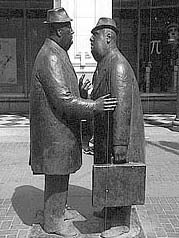 Who knows how long all this will last, this time? But there do seem a number of good reasons to guess that it will enable both BC and Alberta to diversify their provincial economies enough to gain more stable longer-term ground, even after their current resource-economy booms inevitably bust again (as such things always seem to do in the end too). Yet here again what Harold Innis called “our obsession with the moment” in the early 1950s – in Canada and the modern world at large – sometimes seems to be breeding a few too many hasty impressions.
Who knows how long all this will last, this time? But there do seem a number of good reasons to guess that it will enable both BC and Alberta to diversify their provincial economies enough to gain more stable longer-term ground, even after their current resource-economy booms inevitably bust again (as such things always seem to do in the end too). Yet here again what Harold Innis called “our obsession with the moment” in the early 1950s – in Canada and the modern world at large – sometimes seems to be breeding a few too many hasty impressions.
However much more spare change Calgary may have right now, Toronto remains Canada’s most populous metropolitan region, by a considerable margin. And this will likely continue for some time as well (just as Vancouver will also likely remain more populous than Calgary?). Yet in trying to assess just what all this means for the Canadian future, it is probably worth remembering as well that it was only a mere 30 years ago, in 1976, that Toronto itself actually replaced Montreal as Canada’s most populous metropolitan region. And what this really showed – as the Dutch-born historian of Ontario urban development Jacob Spelt explained at the time – was that modern Canada does not have any single “primate centre” of economic growth.
 Harold Innis concluded his mid 1930s account of Ontario economic history with some sentences that may also be worth remembering today. “The emergence of Ontario to maturity has brought problems for the province as well as for” Canada at large. “The elasticity of the economy of Ontario … has been obtained in part through inelastic developments which bear with undue weight on less favoured areas” of the country. “The strength of Ontario may emphasize the weakness of the federation.”
Harold Innis concluded his mid 1930s account of Ontario economic history with some sentences that may also be worth remembering today. “The emergence of Ontario to maturity has brought problems for the province as well as for” Canada at large. “The elasticity of the economy of Ontario … has been obtained in part through inelastic developments which bear with undue weight on less favoured areas” of the country. “The strength of Ontario may emphasize the weakness of the federation.”
If this was true then, it must at least also be true that what is probably happening now finally points to some new injections of strength for the federation of the future. And, as Nelson Wiseman from Manitoba explained a few years ago, “Ontarians lead their fellow Canadians in describing themselves as Canadians first.” So they should finally be happy too – along with other old and new stronger Canadians in such places as Halifax, Montreal, Winnipeg, Edmonton, and Vancouver. (Oh, and by the way Alberta, the very last sentence of Harold Innis’s mid 1930s essay was: “An empire has its obligations as well as its opportunities.” If things just keep going up and up, you’ll probably have to start thinking about just what that means in the 21st century too.)
And on a not unrelated central (and rest-of) Canadian front, from the counterweights editors, Tuesday March 21: MEANWHILE BACK AT TIM HORTON’S .. In Search of Canadian Liberalism .. and the New Democrats
 Anyone inclined to be too critical of Stephen Harper’s rough handling of the media lately may want to recall a legendary backroom story about Patrick Gossage, who served as Pierre Trudeau’s press secretary 19761982. Gossage didn’t have that hard a job, the story goes. All he had to do was “call the media to a meeting and tell them to f… off.”
Anyone inclined to be too critical of Stephen Harper’s rough handling of the media lately may want to recall a legendary backroom story about Patrick Gossage, who served as Pierre Trudeau’s press secretary 19761982. Gossage didn’t have that hard a job, the story goes. All he had to do was “call the media to a meeting and tell them to f… off.”
A newer story from Mr. Gossage himself, in the September 2004 issue of Policy Options magazine, also rings a few bells in the spring of 2006. Called “Fear and loathing in 2004,” it bemoaned how the “suspension of all normal peacetime sense of honesty, proportion and respect for truth” had “reached its zenith in the recent federal Liberal election campaign.”
This is the hard school in which today’s new Conservative minority prime minister of Canada received the last and most important part of his practical political education in Ottawa. And, good student that he is, he now appears determined to apply its lessons in peacetime too. (Or is it just that, in the eyes of Mr. Harper, the time between now and the next actual federal election is just going to be all one long battle anyway, in a new Age of the Permanent Election Campaign?)
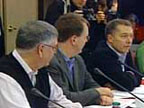 Meanwhile, the officially opposing Liberal Party of Canada has decided that it will choose its next permanent leader on Sunday, December 3, 2006 – at “Montreal’s Palais des congres,” the same spot where the “Conservatives laid the groundwork for the party’s renaissance in Quebec … exactly one year ago.” Another installment of the old national quest that the historian and former social democratic manifesto-writer Frank Underhill christened In Search of Canadian Liberalism 45 years ago has begun. Some say that the big question now is: has the search itself at last come to a bitter end? But others say surely not.
Meanwhile, the officially opposing Liberal Party of Canada has decided that it will choose its next permanent leader on Sunday, December 3, 2006 – at “Montreal’s Palais des congres,” the same spot where the “Conservatives laid the groundwork for the party’s renaissance in Quebec … exactly one year ago.” Another installment of the old national quest that the historian and former social democratic manifesto-writer Frank Underhill christened In Search of Canadian Liberalism 45 years ago has begun. Some say that the big question now is: has the search itself at last come to a bitter end? But others say surely not.
1. Just how much trouble are the Liberals in?
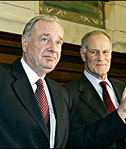 There appears to be no escape from the blunt fact that the federal Liberals in Canada are in quite a lot of trouble at the moment. And this cannot really be surprising. It has even been predicted, most notably in Globe and Mail pundit John Ibbitson’s theory of not too long ago that “the Liberals are Eaton’s.” (They are destined, that is, to suffer the same fate as the old Toronto-headquartered cross-Canada department store chain, which finally went bankrupt in 1999.)
There appears to be no escape from the blunt fact that the federal Liberals in Canada are in quite a lot of trouble at the moment. And this cannot really be surprising. It has even been predicted, most notably in Globe and Mail pundit John Ibbitson’s theory of not too long ago that “the Liberals are Eaton’s.” (They are destined, that is, to suffer the same fate as the old Toronto-headquartered cross-Canada department store chain, which finally went bankrupt in 1999.)
All the same, it still comes as a bit of shock to see the prophecy appear to start to unfold. And even if you don’t have any great love for the Liberals – but are among the more than 63% of the Canada-wide electorate that did not vote for the Conservatives on January 23, 2006 – it is still all too easy to doubt that some ultimate exact fulfillment of “the Liberals are Eaton’s” theory would be all that good for the Canadian people and their future, from coast to coast to coast.
 Fortunately, or otherwise, although the Liberals are undeniably in quite a lot of trouble at the moment, it does also seem clear that they are still some considerable distance from anywhere close to dead yet. The party officialdom is proclaiming that the party is in better financial shape than has lately been rumoured. While currently reputed big names like Frank McKenna and John Manley have declined to run for the leadership, it appears that there will be no dearth of other hopefuls vying for the vote at Montreal’s Palais des congrs on December 3. And anything Belinda Stronach takes an interest in is apparently still good copy for the Canadian press.
Fortunately, or otherwise, although the Liberals are undeniably in quite a lot of trouble at the moment, it does also seem clear that they are still some considerable distance from anywhere close to dead yet. The party officialdom is proclaiming that the party is in better financial shape than has lately been rumoured. While currently reputed big names like Frank McKenna and John Manley have declined to run for the leadership, it appears that there will be no dearth of other hopefuls vying for the vote at Montreal’s Palais des congrs on December 3. And anything Belinda Stronach takes an interest in is apparently still good copy for the Canadian press.
2. Atlantic Canada, Urban Ontario, and Downtown Vancouver
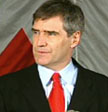 The federal Liberals biggest problem right now is that they suddenly seem far too much of an urban Ontario party, with increasingly shaky branches in Atlantic Canada and Vancouver, and too many still smoldering buildings in their once crucial bastion of francophone Quebec. As matters stand, just too many prospective leadership candidates for December 3 are from just the Greater Toronto Area. A recent short list on the CTV website, e.g., included such GTA metropolites as Bob Rae, Ken Dryden, John Godfrey (who has now already declared), Belinda Stronach, Michael Ignatieff (who lives in Toronto at the moment, but has spent most of the past 30 years outside Canada altogether), Joe Volpe, Carolyn Bennett, and Maurizio Bevilacqua.
The federal Liberals biggest problem right now is that they suddenly seem far too much of an urban Ontario party, with increasingly shaky branches in Atlantic Canada and Vancouver, and too many still smoldering buildings in their once crucial bastion of francophone Quebec. As matters stand, just too many prospective leadership candidates for December 3 are from just the Greater Toronto Area. A recent short list on the CTV website, e.g., included such GTA metropolites as Bob Rae, Ken Dryden, John Godfrey (who has now already declared), Belinda Stronach, Michael Ignatieff (who lives in Toronto at the moment, but has spent most of the past 30 years outside Canada altogether), Joe Volpe, Carolyn Bennett, and Maurizio Bevilacqua.
This perception of Canada’s most populous (and urban) province as a vain last battle ground for a federal Liberal Party in free-falling decline is sharpened by what some see as a parallel Liberal last stand in Ontario provincial politics. Dalton McGunity, an Alberta consultant told a gathering at the Ontario Club in Toronto shortly after the new Harper government took office, is in effect now the leader of the only real Liberal government in the country (the current provincial “Liberal” administrations in BC and Quebec being conservative regimes in only mild disguise). And, as the influential Ontario politics newsletter Inside Queen’s Park has more recently reported: “National Post parliament-watcher John Ivison tells IQP that he sees Ontario premier Dalton McGuinty positioning himself as the principal opponent to PM Stephen Harper.”
3. Looking on the bright side … the bilingual tradition, Carole Taylor, and all that
 Without a doubt, none of this looks good for the federal Liberals. (It all looks a little too much like “the Liberals are Eaton’s” theory just may be coming true.) But there still do seem to be a number of potential reality-checks worth bearing in mind, for the moment at least. The first is that it is still very early days in the Liberal leadership campaign. Things may look different by the end of the summer, say? A second point is that the so-called Conservative “renaissance in Quebec” is as yet a quite green and untested phenomenon. Outside Quebec there are still far more Liberals than Conservatives who speak some kind of serious French, and so forth. Who will in fact be best for Quebec, when all the inflated dust of the sponsorship scandal settles?
Without a doubt, none of this looks good for the federal Liberals. (It all looks a little too much like “the Liberals are Eaton’s” theory just may be coming true.) But there still do seem to be a number of potential reality-checks worth bearing in mind, for the moment at least. The first is that it is still very early days in the Liberal leadership campaign. Things may look different by the end of the summer, say? A second point is that the so-called Conservative “renaissance in Quebec” is as yet a quite green and untested phenomenon. Outside Quebec there are still far more Liberals than Conservatives who speak some kind of serious French, and so forth. Who will in fact be best for Quebec, when all the inflated dust of the sponsorship scandal settles?
A third point is that the federal Liberals still do seem to have considerable individual talent within their ranks – especially when compared to the federal Conservatives. (So much so that Mr. Harper has had to poach David Emerson and appoint Michael Fortier to the Senate, to give credibility to his cabinet.) A fourth point is that people like Carole Taylor in the BC provincial Liberal government still seem more progressive than some conservatives in Alberta might like to think. A fifth point is that it is still far from clear Stephen Harper’s federal Conservatives actually can provide an effective government for the restless confederation. They have only been in office a little more than a month. If not quite as bad as the “very, very bad start” that Liberal president Mike Eizenga alluded to this past weekend, the Harper Conservative performance has been far from brilliantly decisive yet – and many tricky challenges likely enough loom ahead (perhaps especially once the latest fractured Parliament returns to work on April 3?).
 There are no doubt still other points of this sort that might occur to a person striving for balance and seeing things steadily and whole in political analysis. There have been many surprises in Canadian federal politics over the past two years. There may still be many more surprises ahead. Right now it is still far too early to say that Stephen Harper’s Conservatives and their 36.3% of the popular vote on January 23, 2006 have already conquered Canada for a generation – as much as there do seem to be some people who are trying to say it anyway.
There are no doubt still other points of this sort that might occur to a person striving for balance and seeing things steadily and whole in political analysis. There have been many surprises in Canadian federal politics over the past two years. There may still be many more surprises ahead. Right now it is still far too early to say that Stephen Harper’s Conservatives and their 36.3% of the popular vote on January 23, 2006 have already conquered Canada for a generation – as much as there do seem to be some people who are trying to say it anyway.
4. The Liberals and the New Democrats
It may finally be that the biggest stumbling block for any ultimate fulfillment of “the Liberals are Eaton’s” theory is the continuing relative unattractiveness of their only logical successors on the left wing of the Canadian political spectrum, among the federal New Democrats.
 John Ibbitson, e.g., is now arguing that: “Politics in liberal democracies is always about defining the difference between conservatives and progressives. Stephen Harper has come up with a pretty good answer to the question of what it means to be a modern Canadian conservative; the NDP still embraces the old progressive orthodoxies. The traditional Liberal formula – conservative here, progressive there, as the situation requires – no longer seems to sell.” But it is not all that easy to say that the New Democrats’ “old progressive orthodoxies” have been selling all that well lately either, even with the communications skills of Jack Layton.
John Ibbitson, e.g., is now arguing that: “Politics in liberal democracies is always about defining the difference between conservatives and progressives. Stephen Harper has come up with a pretty good answer to the question of what it means to be a modern Canadian conservative; the NDP still embraces the old progressive orthodoxies. The traditional Liberal formula – conservative here, progressive there, as the situation requires – no longer seems to sell.” But it is not all that easy to say that the New Democrats’ “old progressive orthodoxies” have been selling all that well lately either, even with the communications skills of Jack Layton.
It is quite arguable in fact that the most striking thing the New Democrats have done recently is put the one-time neo-conservative ideologue Stephen Harper into the prime minister’s office, in the Canadian federal election of 2006. (Because another contemporary historical truth does appear to be that until the New Democrats joined with the Conservatives and the Bloc Quebecois to bring Paul Martin’s minority Liberal government down this past November, Stephen Harper’s “pretty good answer to the question of what it means to be a modern Canadian conservative” was not selling all that well either.)
5. The Saga of Bev Desjarlais
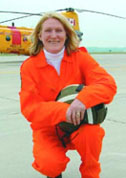 It also seems arguable enough that the progressive majority of the Canadian electorate which actually voted against the Harper Conservatives on January 23 is only now beginning to catch up with the strange confusions of the Liberal-New Democrat dynamic during the 20052006 election campaign. (And who among us wasn’t more than a little confused?) Just where all this may finally lead is still no more than food for future thought. But the most up-to-date fate of former NDP MP Bev Desjarlais may hint at the kinds of New Democrat limitations that will ultimately redound to the Liberals’ advantage.
It also seems arguable enough that the progressive majority of the Canadian electorate which actually voted against the Harper Conservatives on January 23 is only now beginning to catch up with the strange confusions of the Liberal-New Democrat dynamic during the 20052006 election campaign. (And who among us wasn’t more than a little confused?) Just where all this may finally lead is still no more than food for future thought. But the most up-to-date fate of former NDP MP Bev Desjarlais may hint at the kinds of New Democrat limitations that will ultimately redound to the Liberals’ advantage.
Ms. Desjarlais, you may remember, used to be the NDP MP for the northern Manitoba riding of Churchill – until she voted against gay marriage early last summer, and was promptly expelled from the hidebound orthodox New Democrat caucus. She ran again as an Independent this past January 23, and lost. But now she has reappeared in Ottawa as an aide in charge of parliamentary relations for Greg Thompson, the new Conservative Veterans Affairs minister from New Brunswick (who everyone seems to like?). According to press reports: “Some New Democrat MPs say they are shocked by the mind-boggling’ move” to the new Tories on the part of their former colleague. Others are apparently less appalled, and Ms. Desjarlais herself appears even pleased with what she has done. In any case it would seem that you can spin this story out in various directions – none of which qualify as more bad news for the federal Liberals.
6. “Unite the left” … well, sort of …
 As Buzz Hargrove of the Canadian Auto Workers has been urging lately, it is also probably true that both the Liberals and the New Democrats ultimately need each other in Canadian federal politics nowadays – even if the current wise counsellors of neither party as yet seem remotely prepared to face up to this strategic logic like brave women and men. If the Liberals actually were to vanish overnight, and the New Democrats became some aspiring new single mainstream progressive party in Canada, Stephen Harper’s freshly united Conservatives just might wind up conquering the country for a generation.
As Buzz Hargrove of the Canadian Auto Workers has been urging lately, it is also probably true that both the Liberals and the New Democrats ultimately need each other in Canadian federal politics nowadays – even if the current wise counsellors of neither party as yet seem remotely prepared to face up to this strategic logic like brave women and men. If the Liberals actually were to vanish overnight, and the New Democrats became some aspiring new single mainstream progressive party in Canada, Stephen Harper’s freshly united Conservatives just might wind up conquering the country for a generation.
Or, as John Manley put it recently, the Liberals are still the only mainstream Canadian political party that is “socially progressive and economically responsible.” (Also the main problem with former Ontario NDP leader Bob Rae’s current thoughts about running for the federal Liberal leadership.) They certainly do need to abandon the fear and loathing of the 2004 federal campaign – and reach out aggressively to all corners of Canada’s vast and magnificent human geography. And maybe they need to start appreciating that they ought to be working more closely with especially those Western Canadian New Democrats who themselves want to move beyond their own fading orthodoxies and into the new progressive future of the 21st century, and all that.
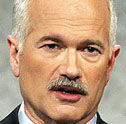 Yet the only people of Canada who have any serious objective interest in seeing “the Liberals are Eaton’s” theory come true are the Conservatives (and perhaps but just perhaps the still resolutely sovereigntist factions of the Bloc Quebecois?). When and if enough Liberals and New Democrats together start to internalize this deepest new political truth the Canadian progressive future could start to look bright again. Probably the left does not need and should not try to imitate “unite the right” in any formal way. But it does need to work together when the chips are down. In Canada’s current circumstances that appears be the most obvious practical political lesson of the 2006 federal election – for progressive voters and activists alike.
Yet the only people of Canada who have any serious objective interest in seeing “the Liberals are Eaton’s” theory come true are the Conservatives (and perhaps but just perhaps the still resolutely sovereigntist factions of the Bloc Quebecois?). When and if enough Liberals and New Democrats together start to internalize this deepest new political truth the Canadian progressive future could start to look bright again. Probably the left does not need and should not try to imitate “unite the right” in any formal way. But it does need to work together when the chips are down. In Canada’s current circumstances that appears be the most obvious practical political lesson of the 2006 federal election – for progressive voters and activists alike.

